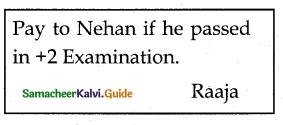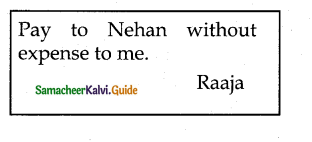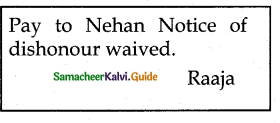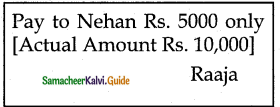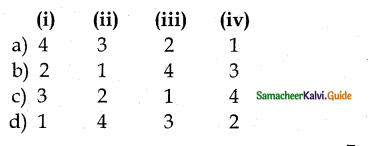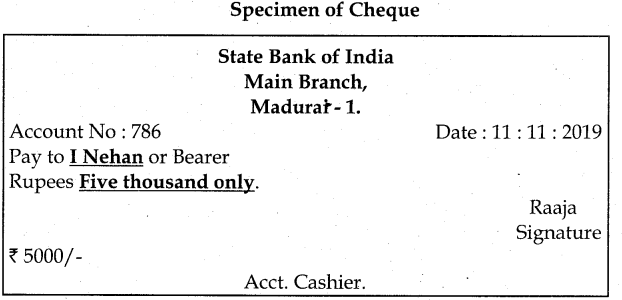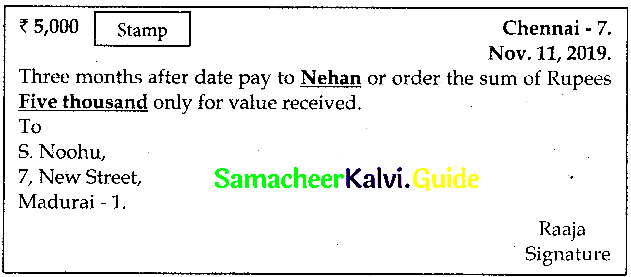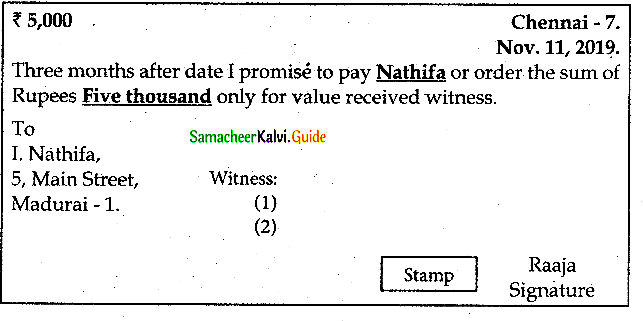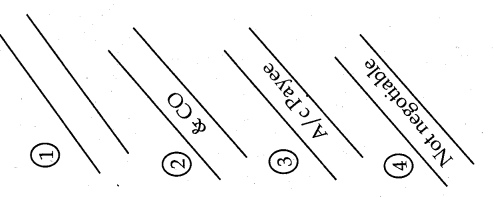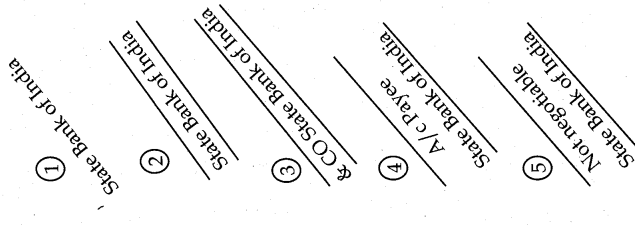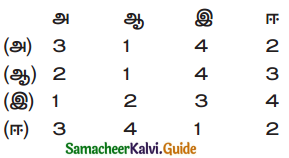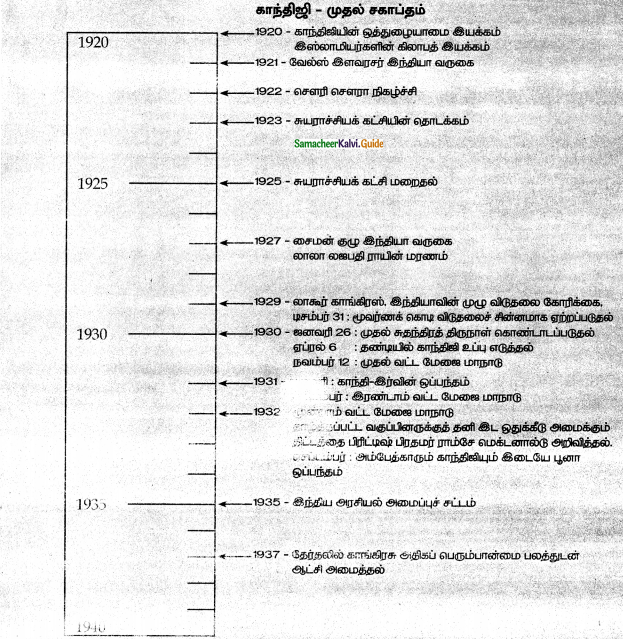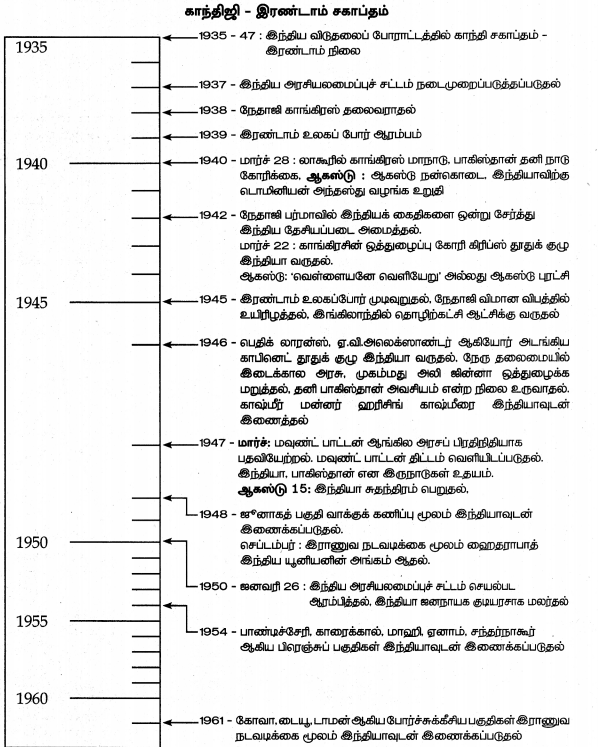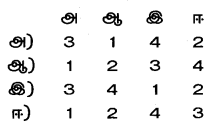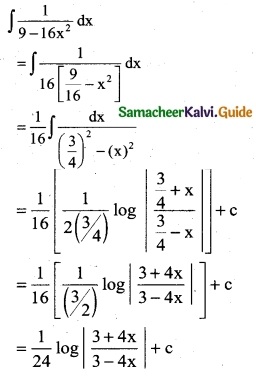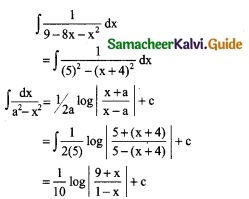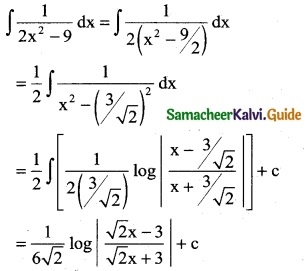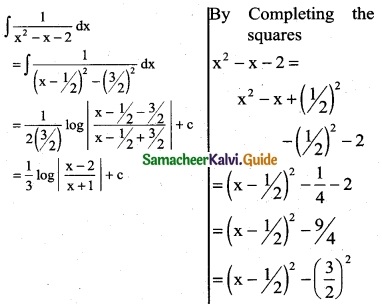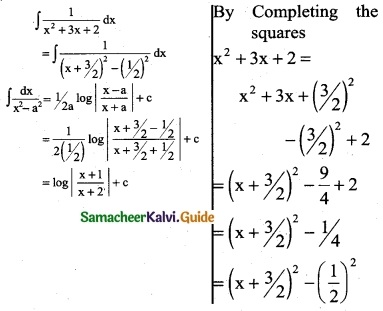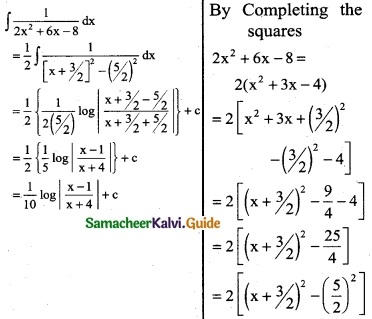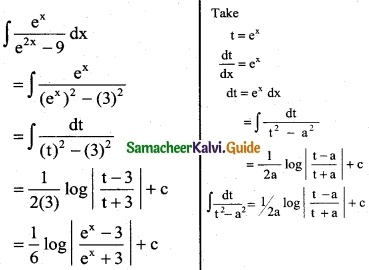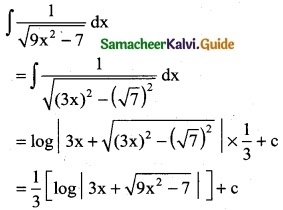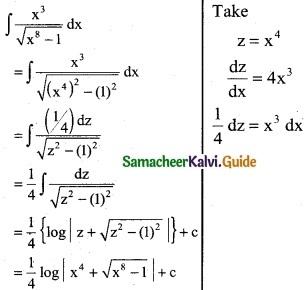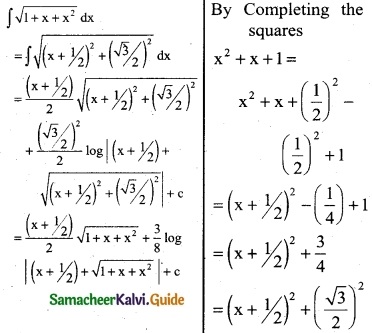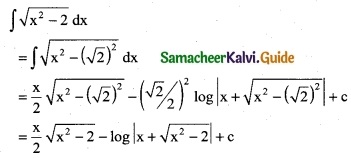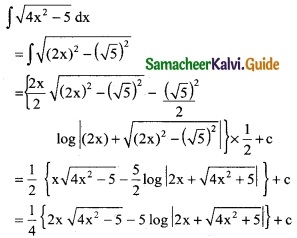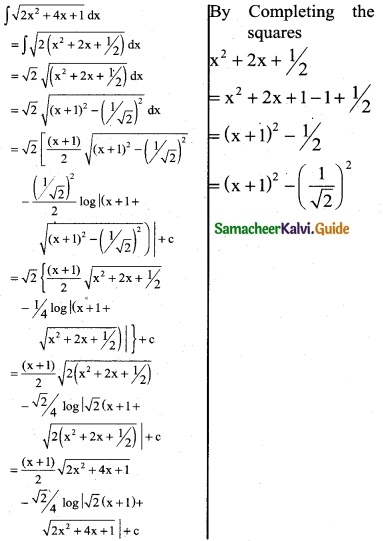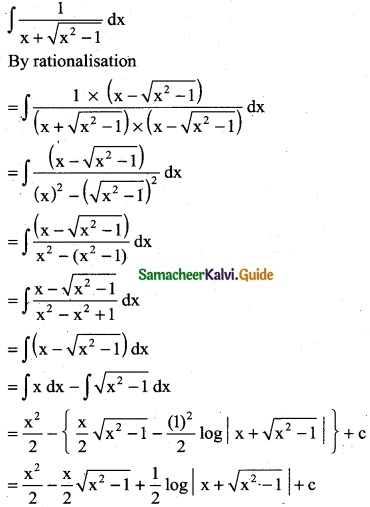Tamilnadu State Board New Syllabus Samacheer Kalvi 12th History Guide Pdf Chapter 5 ஏகாதிபத்தியத்திற்கு எதிரான போராட்டங்களில் புரட்சிகர தேசியவாதத்தின் காலம் Text Book Back Questions and Answers, Notes.
Tamilnadu Samacheer Kalvi 12th History Solutions Chapter 5 ஏகாதிபத்தியத்திற்கு எதிரான போராட்டங்களில் புரட்சிகர தேசியவாதத்தின் காலம்
12th History Guide ஏகாதிபத்தியத்திற்கு எதிரான போராட்டங்களில் புரட்சிகர தேசியவாதத்தின் காலம் Text Book Questions and Answers
I. சரியான விடையைத் தேர்ந்தெடுக்கவும்
Question 1.
இந்தியக் கம்யூனிஸ்ட் கட்சி எந்த ஆண்டு தொடங்கப்பட்டது?
அ) 1920
ஆ) 1925
இ) 1930
ஈ) 1935
Answer:
ஆ) 1925
Question 2.
கல்பனா தத் எதனுடன் தொடர்புடையவர்?
அ) ஹிந்துஸ்தான் சோசலிஸ்ட் ரிபப்ளிகன் அசோசியேஷன்
ஆ) வங்காள சபை
இ) இந்திய கம்யூனிஸ்ட் கட்சி
ஈ) இந்தியக் குடியரசு இராணுவம்
Answer:
ஈ) இந்தியக் குடியரசு இராணுவம்
![]()
Question 3.
பின்வருவனவற்றைப் பொருத்துக.
அ. கான்பூர் சதி வழக்கு – 1.அடிப்படை உரிமைகள்
ஆ. மீரட் சதி வழக்கு – 2. சூரியா சென்
இ. சிட்டகாங் ஆயுதக் கிடங்கு – 3. 1929
ஈ. இந்திய தேசிய காங்கிரசின் கராச்சி மாநாடு 4. 1924
அ)1,2,3,4
ஆ) 2,3,4,1
இ) 3,4,1,2
ஈ) 4,3.2.1
Answer:
ஈ) 4,3,2,1
Question 4.
கீழ்க்காண்பவர்களில் 64 நாட்கள் உண்ணாவிரதத்திற்குப் பிறகு சிறையில் உயிரிழந்தவர் யார்?
அ) புலின் தாஸ்
ஆ) சச்சின் சன்யால்
இ)ஜதீந்திரநாத் தாஸ்
ஈ) பிரித்தி வதேதார்
Answer:
இ) ஜதீந்திரநாத் தாஸ்
Question 5.
பின்வரும் கூற்றுகளில் பொருளாதாரப் பெரும் மந்தம் குறித்துச் சரியானவை.
i) இது வட அமெரிக்காவில் ஏற்பட்டது
ii) வால் தெருவில் ஏற்பட்ட வீழ்ச்சியானது பெரும் மந்தத்தை விரைவுபடுத்தியது.
iii) பெரும் மந்தம் வசதி படைத்தவர்களை மட்டுமே பாதித்தது
iv) விலை வீழ்ச்சி அடைந்ததால் பெரும் மந்தத்தின் போது சிறப்பான வாழ்க்கை முறையை தொழிலாளர்கள்
அனுபவித்தனர்.
அ) i மற்றும் ii
ஆ) i, ii மற்றும் iii
இ) மற்றும் iv
ஈ) i, iii மற்றும் iv
Answer:
அ) i மற்றும் ii
![]()
Question 6.
முதலாவது பருத்தித் தொழிற்சாலை பம்பாயில் தொடங்கப்பட்ட ஆண்டு
அ)1852
ஆ) 1854
இ) 1861
ஈ) 1865
Answer:
ஆ) 1854
Question 7.
கொடுக்கப்பட்ட குறிப்புகளை கொண்டு சரியான கூற்றைத் தேர்ந்தெடுக்கவும்.
i) “ChittagongArmoury Raiders Reminiscences” எனும் நூல்கல்பனாதத் என்பவரால் எழுதப்பட்டது.
ii) கல்பனா தத்தாய்நாட்டின் விடுதலைக்காக ஆயுதம் தாங்கி போராடினார்
iii) கல்பனாதத் பேரரசருக்கு எதிராகப் போர் தோடுத்தார் எனக் குற்றஞ்சாட்டப்பட்டார்.
அ) மட்டும்
ஆ) 1 மற்றும் ii
இ) ii மற்றும் iii
ஈ) அனைத்தும்
Answer:
ஈ) அனைத்தும்
Question 8.
முதலாவது பயணிகள் இரயில் 1853 இல் எந்த இடங்களுக்கு இடையே ஓடியது?
அ. மதராஸ் – அரக்கோணம்
ஆ. பம்பாய் – பூனா
இ. பம்பாய் – தானே
ஈ. கொல்கத்தா – ஹூக்ளி
Answer:
இ) பம்பாய தானே
![]()
Question 9.
கல்கத்தாவில் முதலாவது சணல் ஆலை தொடங்கப்பட்ட ஆண்டு ………
அ)1855
ஆ) 1866
இ) 1877
ஈ) 1888
Answer:
அ) 1855
Question 10.
பின்வருவோரில் கான்பூர் சதி வழக்கில் கைது செய்யப்பட்டவர் யார்?
அ) எம்.என்.ராய்
ஆ) பகத் சிங்
இ)எஸ்.ஏ.டாங்கே
ஈ) ராம் பிரசாத் பிஸ்மில்
Answer:
அ) எம்.என்.ராய்
Question 11.
கான்பூர் சதி வழக்குக் குறித்த பின்வரும் எந்த கூற்றுகள் சரியானவை?
i) சணல் மற்றும் பருத்தி தொழிற்சாலைகளில் தொழிற்சங்கங்கள் தோன்றின.
ii) இவ்வழக்கில் கம்யூனிஸ்ட்களும் தொழிற்சங்கவாதிகளும் குற்றஞ்சாட்டப்பட்டனர்.
iii) இவ்வழக்கு நீதிபதி H.E.ஹோம்ஸ் என்பவரின் முன்பாக விசாரணைக்கு வந்தது.
iv) விசாரணைமற்றும் சிறைத்தண்டனையானது இந்தியாவில் காங்கிரஸ் நடவடிக்கைகளில் விழிப்புணர்வை ஏற்படுத்தியது.
அ) i, ii மற்றும் iii
ஆ) i, iii மற்றும் iv
இ) ii, iii மற்றும் iv|
ஈ) i, ii மற்றும் iv
Answer:
ஈ) i, ii மற்றும் iv
![]()
II. சுருக்கமான விடையளிக்கவும்
Question 1.
இந்தியாவில் கம்யூனிஸ்ட் கட்சியை உருவாக்க கிரேட் பிரிட்டனால் அனுப்பப்பட்ட மூன்று ஆங்கில கம்யூனிசவாதிகளின் பெயர்களைக் குறிப்பிடுக.
Answer:
இந்தியாவில் கம்யூனிஸ்ட் கட்சியை கட்டியமைக்க உதவுவதற்கென பிரிட்டானிய கம்யூனிஸ்ட் கட்சியால் அனுப்பிவைக்கப்பட்ட கம்யூனிஸ்ட்டுகள்.
- பிலிப் ஸ்ப்ராட்
- பான் ப்ராட்லி
- லெஸ்டர் ஹட்சின்சன் ஆகியோர் ஆவார்.
Question 2.
மீரட் சதி வழக்கில் குற்றம் சாட்டப்பட்ட குற்றவாளிகளுக்கு ஆதரவாக வாதாடிய வழக்கறிஞரை அடையாளப்படுத்துக.
Answer:
கே.எஃப் நாரிமன், எம்.சி.சக்லா போன்ற புகழ்பெற்ற வழக்கறிஞர்கள் மீரட் சதி வழக்கில் குற்றம் சாட்டப்பட்ட குற்றவாளிகளுக்கு ஆதரவாக வாதாடினர்.
![]()
Question 3.
புகழ்பெற்ற கோரக்பூர் நீதிபதியான H.E. ஹோம்ஸ் பற்றி நீவிர் அறிவது யாது?
Answer:
அமர்வு நீதிபதி H.E. ஹோம்ஸ் முன்னிலையில் விசாரணைக்கு வந்தது. இவர் கோரக்பூர் அமர்வு நீதிபதியாக பணியாற்றிய போது சௌரிசௌரா வழக்கில் தொடர்பு கொண்டவர்களாக குற்றம் சாட்டப்பட்ட 172 விவசாயிகளுக்கு மரண தண்டனை விதித்து தீர்ப்பளித்து பிரசித்தி பெற்றவர்.
Question 4.
இரண்டாவது லாகூர் சதி என்றறியப்படும் நிகழ்வு யாது?
Answer:
- ராஜகுரு, சுகதேவ். ஜஹீந்திரநாத் தாஸ் ஆகியோருடன் பகத்சிங்கும் மேலும் 21 பேரும் கைது செய்யப்பட்டு, “சாண்டர்ஸ் கொலை” தொடர்பான விசாரணைக்கு ஆளாக்கப்பட்டனர்.
- இந்த வழக்கு இரண்டாவது லாகூர் சதி வழக்கு என்று அறியப்படுகிறது.
- இதில் ஜஹிந்திரநாத் தாஸ் என்பவர் சிறையின் மோசமான நிலை, பாரபட்சமான நடவடிக்கைகளை எதிர்த்து 64 நாட்கள் உண்ணாவிரதம் மேற்கொண்டு, சிறையிலேயே மரணமடைந்தார்.
Question 5.
இந்தியாவின் நவீன தொழிற்சாலையின் தந்தை என ஜே.என். டாடா அழைக்கப்பட காரணம் என்ன ?
Answer:
- ஜே.என்.டாடா என்கிற ஜாம்ஷெட்ஜி நுஸவர்வஞ்சி டாடா பரோடாவில் உள்ள நல்சாரி என்ற இடத்தில் ஒரு பார்சி வணிக குடும்பத்திலிருந்து வந்தவர்.
- இந்தியாவின் முதல் வெற்றிகரமான தொழிலதிபர் இவர் என்பதால், “இந்திய நவீனத் தொழிலகங்களின் தந்தை” என அழைக்கப்படுகிறார்.
![]()
III. குறுகிய விடையளிக்கவும்
Question 1.
சிட்டகாங் ஆயுதப் படைத் தாக்குதலை நடத்த சூரியாசென் எவ்வாறு திட்டமிட்டார்?
Answer:
- சூரியா சென்னின் புரட்சிக் குழுவான இந்தியக் குடியரசு இராணுவம் சிட்டகாங்கை கைபற்ற மறைந்திருந்து தாக்கும் கொரில்லா பாணி தாக்குதலை நடத்த திட்டமிட்டனர்.
- 1930 ஏப்ரல் 18 அன்று இரவில் சிட்டகாங் படைத்தளம் தாக்கி தகர்க்கப்பட்டது.
- மாகாணத்தின் பிற பகுதிகளிலிருந்து தனிமைப்படுத்தும் முகமாக ரயில்வே தகவல்தொடர்பு வலை பின்னல்களை துண்டிக்கும் பொருட்டு தந்தி, அலுவலகங்கள், படைத்தளங்கள், காவல்துறை முகாம்கள் போன்றவைகளை தகர்த்தனர்.
- காலனிய நிர்வாகத்திற்கு நேரடியாக சவால் விடுக்கும் நோக்குடன் அது நடந்தேறியது.
Question 2.
டாடா இரும்பு மற்றும் எஃகு நிறுவனம் (TISCO) பற்றி குறிப்பு எழுதுக.
Answer:
- 1907ல் பீகாரில் உள்ள சாகிநகரில் டாடா குழுமத்தால் டாடா இரும்பு மற்றும் எஃகு நிறுவனம் (TISCO) முதன்முதலில் சுதேசி இயக்கத்தின் ஒரு நிகழ்வாக அமைக்கப்பட்டது.
- இந்தத்துறையில் உள்ள மற்ற முயற்சியாளர்களை விட டாடா மிக உன்னத நிலையை அடைந்துள்ளது.
- அதன் உற்பத்தி 1912-13ல் 31,000 டன்னிலிருந்து 1917-18ல் 1,81000 டன்னாக அதிகரித்தது.
![]()
Question 3.
தென்னிந்தியாவில் தொழிற்சங்கங்களின் வளர்ச்சிக்காகச் சிங்காரவேலர் ஆற்றிய பங்களிப்புக் குறித்து எழுதுக.
Answer:
- சிங்காரவேலர் இளமைகாலத்தில் புத்தமதத்தை தழுவினார், பிறகு இந்திய தேசிய காங்கிரஸில் இணைந்து செயல்பட்டார்.
- எனினும் சில காலத்திற்குப்பிறகு அவர் புரட்சிகர தேசியவாத பாதையை தேர்ந்தெடுத்தார்.
- திரு.வி.கல்யாண சுந்தரத்துடன் இணைந்து தென்னிந்தியாவில் பல தொழிற்சங்கங்களை தோற்றுவித்தார்
- 1923 ஆம் ஆண்டு மே மாதம் முதல் நாள் முதன் முறையாக நாட்டில் மேதினத்தை கொண்டாடினார்.
- 1928ல் தென்னிந்திய ரயில்வே வேலை நிறுத்தத்தை (பொன்மலை, திருச்சிராப்பள்ளி) ஏற்பாடு செய்ததில் இவர் முக்கியப் பங்கு வகித்தள் அதற்காக தண்டனை பெற்றார்.
IV. விரிவான விடையளிக்கவும்
Question 1.
பகத்சிங்கின் புரட்சிகர தேசியவாதம் மற்றும் புரட்சிகர நடவடிக்கைகள் எவ்வாறு அவரைத் தூக்கு மேடைக்கு இட்டுச் சென்றது? (மார்ச் 2020)
Answer:
பகத்சிங்கின் பின்புலம்:
- தேசியவாதத்தின் ஓர் ஒப்பற்ற நிலையைப் பகத்சிங் பிரதிநிதித்துவப் படுத்துகிறார். அவருடைய புரட்சிகர
தேசியவாத நிலைப்பாடு, ஒரு தனித்த வழி என்ற அளவில் ஒட்டுமொத்த விடுதலை இயக்கத்தின் லட்சியங்களுக்காகப் பெரிதும் பாராட்டப்படுகிறது. - பகத்சிங்கின் 14ஆம் வயதில் ஜாலியன் வாலாபாக் படுகொலை நிகழ்ந்தது. அவர் தனது இளமைக் காலம் முதலாகவே, நவ்ஜவான் பாரத் சபா, ஹிந்துஸ்தான் ரிபப்ளிகன் அசோசியேஷன் ஆகிய அமைப்புகளில் தன்னை இணைத்துக்கொண்டார்.
- 1929 ஆம் ஆண்டு ஏப்ரல் மாதம் 8 ஆம் தேதி மத்திய சட்டமன்றத்தில் வீசிய குண்டுகள் எவரையும் கொல்லவில்லை. ஆங்கிலேயர்களின் கொடுங்கோன்மைச் சட்டங்களுக்கு எதிரான ஒரு போராட்டச்
செயலாக புரட்சியாளர்களால் அது கருதப்பட்டது.
![]()
Question 2.
1919 – 1939 ஆம் ஆண்டுகளுக்கிடையில் காலனி ஆதிக்க இந்தியாவில் ஏற்பட்ட தொழில் வளர்ச்சியினைப் பற்றி எழுதுக.
Answer:
- பிரிட்டிஷ் வணிகக் கொள்கையானது உள்நாட்டுத் தொழிற்துறையைப் பெரும் எண்ணிக்கையாக்கியது.
- முதல் உலகப்போரின் போதும் பொருளாதாரப் பெருமந்தம் போன்ற சில எதிர்பாராத சந்தர்ப்பங்கள் காரணமாகவும் இந்தியாவில் தொழில்துறை விரிவாக்கம் ஏற்பட்டது. –
- போர்களுக்கு இடைப்பட்ட காலப்பகுதி உற்பத்தி தொழில்களின் வளர்ச்சியை பாதித்துள்ளது.
- ஆச்சிரியத்தக்க வகையில் இந்திய தொழில்களின் வளர்ச்சி சிறப்பாக இருந்தது.
- 1923-24இல் ஒரு சிறிய தடுமாற்றத்திற்குப் பிறகு, நெசவுத் தொழில் சிறப்பாக செயல்படத் தொடங்கியது.
- 1929-30ல் இந்தியாவால் 44 சதவீதம் வெளியில் இருந்து நுகர்வு செய்யப்பட்ட பருத்திப் பொருட்கள் 1933-34இல் பெருமந்த நிலைக்குப் பிறகு, 20.5 சதவீதமாகக் குறைந்துவிட்டது.
- வளர்ச்சி அடைந்த ஏனைய இரண்டு தொழில்கள் சர்க்கரை உற்பத்தியும் சிமெண்ட் உற்பத்தியுமாகும்.
- போர்களுக்கு இடைப்பட்ட ஆண்டுகளில் கப்பல் தொழிலும் வளர்ச்சியைக் கண்டது. இந்தியா நீராவிக்
கப்பல் கம்பெனி லிமிடெட் (1919) ஏனையவற்றிற்கு முன்னோடியாக இருந்தது. – - 1939இல், அவர்கள் பிரிட்டிஷாரின் பம்பாய் நீராவிக் கப்பல் நிறுவனத்தையும் வாங்கிவிட்டனர்.
- இரண்டாம் உலகப்போருடன் ஒரு புதிய கட்ட உற்பத்தி துவங்கி. அது இயந்திர உற்பத்தி, விமானப் போக்குவரத்து. ரயில் பெட்டி, ரயில் எஞ்சின் உற்பத்தி மற்றும் பலவற்றிற்கான உற்பத்தித் தொழில்களாய் விரிவடைந்தது.
Question 3.
பொருளாதாரப் பெரும் மந்தம் ஏற்பட்ட போது சமூக, பொருளாதார மற்றும் அரசியல் லட்சியங்கள் வெளிப்படுத்துவதில் இந்திய தேசிய காங்கிரசின் கராச்சி மாநாட்டின் முக்கியத்துவத்தை ஆய்வு செய்க.
Answer:
- இந்திய தேசிய காங்கிரஸ், புரட்சியாளர்களின் வன்முறைச் செயல்களுக்கு மாறாக, வன்முறையற்ற போராட்டங்களுக்கு மக்களை அணி திரட்டியது.
- தனது சட்டமறுப்பு இயக்கத்தின் ஒரு பகுதியாக காங்கிரஸ் குத்தகை செலுத்தா மற்றும் வரிசெலுத்தாப் போராட்டத்தைக் கடைபிடித்தது.
- பெருமந்த அழுத்தத்தினால் ஏற்பட்ட சமூக- பொருளாதாரத் தேவைகள் கராச்சியின் காங்கிரஸ் அமர்வில் தீவிரமாய் பேசப்பட்டது.
- விடுதலைப் போராட்டம் ஒரு புதிய வடிவம் பெற்றது. விவசாயிகள் கிசான் சபா எனப்படும் விவசாயிகள் சங்கத்தில் தங்களை இணைத்துக் கொண்டும் தொழிலாளர்கள் தொழிற்சங்கங்களில் இணைந்து கொண்டும் தங்களது பெரிய அளவிலான ஈடுபாட்டை சுதந்திரப் போராட்டக்களத்தில் உயர்த்தினர்.
- நேருவின் தலைமையின் கீழ் வந்த காங்கிரஸ் சமூக மற்றும் பொருளாதார நீதி அடிப்படையில் ஒரு சமத்துவ சமூகத்தைப் பற்றிப் பேச ஆரம்பித்தது.
- 1931 மார்ச்சில் நடந்த கராச்சி அமர்வு சர்தார் வல்லபாய் படேல் தலைமையில் அடிப்படை உரிமைகள் மற்றும் கடமைகளில் ஒரு தீர்மானத்தை நிறைவேற்றிய தோடல்லாமல் சுதந்திர இந்தியாவின் பொருளாதார கொள்கை பற்றிய ஒரு பார்வையை வழங்கியது.
- அடிப்படை உரிமைகள் தீர்மானத்தை மேலோட்டமாய் பார்த்தால் கூட பிரிட்டிஷாரால் நமது அடிப்படை உரிமைகள் எப்படியெல்லாம் மறுக்கப்பட்டுள்ளது என்பது தெரியும்.
- அதனால்தான் அடிப்படை உரிமைகள் தீர்மானத்தில் முக்கிய இடம் பிடித்துள்ளது.
- கொடூரமான சட்டங்கள் போட்டும், அடக்குமுறைகளைக் கையாண்டும் மக்களின் சுதந்திரத்தைக் காலனியரசு நசுக்கியது.
- சுதந்திர இந்தியாவில் இந்திய தேசிய காங்கிரஸ் தான் வழங்க உறுதி அளித்துள்ள உரிமைகள் பட்டியலில் காந்தியக் கொள்கைகளும் நேருவின் சோசலிஷப் பார்வைகளும் இடம் பெற்றன.
![]()
12th History Guide ஏகாதிபத்தியத்திற்கு எதிரான போராட்டங்களில் புரட்சிகர தேசியவாதத்தின் காலம் Additional Questions and Answers
I. சரியான விடையைத் தேர்ந்தெடுக்கவும்
Question 1.
எம்.சிங்கார வேலர் இளமைகாலத்தில் …………… மதத்தை தழுவினார்.
அ) இந்து
ஆ) ஜைன சமயம்
இ) புத்தமதம்
ஈ) கிறித்துவம்
Answer:
இ) புத்தமதம்
Question 2.
ஆங்கிலேய அரசினால் கொடுக்கப்பட்ட அனைத்து கம்யூனிஸ்ட் சதி வழக்குகளிலும் பெரிதும் புகழ்பெற்றதும்……………………..
அ) கான்பூர் சதி வழக்கு
ஆ) மீரட்சதிவழக்கு
இ) லாகூர் சதி வழக்கு
ஈ) பெஷாவர் சதிவழக்கு
Answer:
ஆ) மீரட்சதிவழக்கு
![]()
Question 3.
பொருத்துக.
1. கான்பூர் வதிவழக்கு 1. 1929
2 2வது லாகூர் சதிவழக்கு 2. 1922
3 மீரட் சதிவழக்கு 3. 1924
4 பெஷாவர் சதிவழக்கு 4. 1930
அ) 3,4,1,2
ஆ) 3,1,2,4
இ) 1,2,3,4
ஈ) 4, 3, 2, 1
Answer:
அ) 3,4,1,2
Question 4.
ரஷ்யாவில் அக்டோபர் புரட்சி நடை பெற்ற ஆண்டு ………….
அ) 1917
ஆ) 1927
இ) 1919
ஈ) 1922
Answer:
அ) 1917
Question 5.
1931 – 1936 க்கு இடைப்பட்ட காலத்தில் மாகானத்தில் உள்ள சர்க்கரை ஆலைகளில் உயிருந்து ………….. ஆக உயர்ந்த து. அ)7
ஆ) 9
ஆ) 9
இ) 11
ஈ) 13
Answer:
இ) 11
![]()
Question 6.
நாட்டில் முதன் முதலில் மே தினம் கொண்டாடப்பட்ட ஆண்டு …………
அ) 1921 மே 1
ஆ) 1922 மே 1
இ) 1923 மே 1
ஈ) 1924 மே 1
Answer:
இ) 1923 மே 1
Question 7.
பகத்சிங் சட்டமன்றத்தில் குண்டு வீசிய நிகழ்வு நடைபெற்ற நாள் ……………
அ) 1928 ஏப்ரல் 8
ஆ) 1929 ஏப்ரல் 8
இ) 1929 ஜீலை 8
ஈ) 1927 பிப்ரவரி 18
Answer:
ஆ) 1929 ஏப்ரல் 8
Question 8.
டாடா நீர் மின் சத்தி நிறுவனம் உதயமான ஆண்டு ……….
அ) 1908
ஆ) 1910
இ) 1912
ஈ) 1914
Answer:
ஆ) 1910
![]()
Question 9.
தாய்நாட்டை காப்பதற்காக விடுதலை போரில் ஆயுதம் தாங்கிய இளம் பெண்
அ) கஸ்தூரி பாய்
ஆ) கல்பனா தத்
இ) ஜான்சிராணி
ஈ) டாக்டர். முத்துலெட்சுமி
Answer:
ஆ) கல்பனா தத்
II. சுருக்கமான விடையளிக்கவும்
Question 1.
புரட்சிகர தேசிய வாதக்குழு பற்றி அறிவது யாது?
Answer:
- இந்தியாவில் ஏகாதிபத்தியத்திற்கு எதிரான போராட்டங்களில் ஒரு புதிய புரட்சிகர தேசியவாத சகாப்தம் தோன்ற வழிவகுத்தது.
- 1921 ஆண்டு ஜூன் மாதம் 3 ஆம் தேதி முதல் தேசியவாதக் குழுவினர் பெஷாவருக்கு வந்தனர். ரஷ்ய கம்யூனிஸ்ட் இயக்கத்தினரான போல்ஷ்விக்குகள் வந்துள்ளனர் என்று குற்றம் சாட்டி அவர்கள் உடனடியாகக் கைது செய்யப்பட்னர்.
- 1922, 1927 ஆம் ஆண்டுகளுக்கிடையில் அவர்கள் மீது தொடர்ச்சியாக ஐந்து சதி வழக்குகள் தொடுக்கப்பட்டன.
Question 2.
‘கம்யூனிஸ்ட்டுகளின் பாதுகாப்புகுழு’ ஏன் ஏற்படுத்தப்பட்டது?
Answer:
ஆங்கிலேயர்களால் குற்றம் சாட்டப்பட்ட கம்யூனிஸ்டுகளுக்கு ஆதரவாக வாதாட வழக்கறிஞர்களை அமர்த்தவும், நிதி திரட்டவும் ‘கம்யூனிஸ்ட்டுகளின் பாதுகாப்புக் குழு’ உருவாக்கப்பட்டது.
Question 3.
கான்பூர் சதி வழக்கில் சிறை தண்டனை பெற்றோர் யாவர்?
Answer:
கான்பூர் சதிவழக்கில் முசாபர் அகமது, சவுகது உஸ்மாகி, நளினி குப்தா, எஸ்.ஏ.டாங்கே ஆகியோர் நான்கு ஆண்டுகள் கடுங்காவல் தண்டனை அனுபவிப்பதற்காக சிறைக்கு அனுப்பப்பட்டனர்.
![]()
III. குறுகிய விடையளிக்கவும்
Question 1.
பொருளாதாரப் பெருமந்தத்தின் போது தமிழ்நாட்டில் தொழில்துறை வளர்ச்சியைப் பற்றி கூறுக
Answer:
- சென்னை மாகாணத்தில் தொழில்துறை வளர்ச்சி கனிசமாக இருந்தது.
- கோயம்புத்தூரில் 1896ல் ஸ்டேன்ஸ் மில் (கோயம்புத்தூர் நூற்பு மற்றும் நெசவு ஆலை) நிறுவப்பட்ட பின் வேறு எந்த ஆலைகளும் வரவில்லை .
- பொருளாதாரப் பெருமந்தத்தால் ஏற்பட்ட நிலத்தின் விலை வீழ்ச்சி, குறைந்த ஊதியத்தில் தொழிலாளர்கள், குறைந்த வட்டி விகிதத்தில் கடன் போன்றவை கோயம்புத்தூரில் ஜவுளித்துறையின் விரிவாக்கத்திற்கு வழிவகுத்தனர்.
- 1929-37 களில் கோயம்புத்தூரில் 29 ஆலைகள் மற்றும் விதை நீக்கும் தொழிற்சாலைகள் தோன்றின.
- 1932ல் கோயம்புத்தூர் மாவட்டத்தில் மதுக்கரை என்ற இடத்தில் சிமெண்ட் தொழிற்சாலை தொடங்கப்பட்டது.
- 1931 நமக்கு இடையில் சர்க்கரை ஆலைகள் உலிருந்து 11 ஆக உயர்ந்தது.
- இதே காலத்தில் அரிசி ஆலைகள், எண்ணெய் ஆலைகள் மற்றம் சினிமா நிறுவனங்களின் பெருக்கமும் அதிகரித்தது.
Question 2.
இந்தியாவில் இந்திய கம்யூனிஸ்ட் கட்சி உருவானது எவ்வாறு?
Answer:
- இந்தியாவில் இந்திய கம்யூனிஸ்ட் கட்சியை கட்டி அமைக்க உதவுவதற்காக பிரிட்டானிய கம்யூனிஸ்ட் கட்சியிலிருந்து பிலிப் ஸ்ப்ராட், பான் ப்ராட்லி, லெஸ்டர் ஹட்சின்சன் ஆகிய மூவரும் இந்தியாவிற்கு அனுப்பப்பட்டனர்
- கான்பூர் சதிவழக்கின் விசாரனையின் போது மேற்கூறிய மூவரும், சில தலைவர்களும் கைது செய்யப்பட்டனர்.
- இது புரட்சிகர தேசிய வாதத்தின் உணர்வை மழுங்கடிப்பதற்கு பதிலாக கம்யூனிஸ்ட்களின் நடவடிக்கைகளுக்கு உத்வேகமாக அமைந்தது.
- 1925 ஆம் ஆண்டு டிசம்பர் மாதத்தில் இந்தியாவெங்கிலும் இருந்துவந்த பல்வேறு கம்யூனிஸ்ட்டு குழுக்களின் மாநாடு பம்பாயில் நடந்தேறியது. இந்த மாநாட்டில் தமிழ்நாட்டிலிருந்து M.சிங்கார வேலர் கலந்து கொண்டார்.
- அங்குதான் பம்பாயைத் தலைமையிடமாகக் கொண்டு இந்திய மண்ணில் முறைப்படியாக இந்திய கம்யூனிஸ்ட் கட்சி’ நிறுவப்பட்டது.
![]()
Question 3.
‘கல்பனா தத்’ என்னும் வீரப் பெண்மணிபற்றிய குறிப்பு தருக.
Answer:
- 1920களின் பிற்பகுதியில் கல்பனா தத் என்னும் ஓர் இளம் பெண் சிட்டகாங் ஆயுதப்படைத் தளத்தை துணிகரமாகத் தாக்கியதன் மூலம் இளம் நெஞ்சங்களில் தேசபத்தியை கனன்ஹழச் செய்தவர்.
- ஆணாதிக்கமாக்க இச்சமூகத்தில் தாய்நாட்டைக் காப்பதற்காய் இளம் பெண்களின் பிரதிநிதியாய் விடுதலைப்போரில் ஆயுதம் தாங்கி கல்பனா தத் பங்கேற்றார்.
- புரட்சிகர சிட்டகாங் இயக்கத்தில் தீவிரமாய் பங்கேற்றதினால் கைது செய்யப்பட்டு நாடு கடத்தப்பட்டார்.
IV. விரிவான விடையளிக்கவும்
Question 1.
மீரட் சதி வழக்கின் விசாரணையும், தண்டனையும் பற்றி ஆய்க.
Answer:
விசாரணை:
- மீரட்சதி வழக்கில் பாதுகாப்பு நடவடிக்கைகளை ஒருங்கிணைப்பதற்காக ஒரு தேசிய மீரட் சிறைவாசிகளின் பாதுகாப்புக் குழு ஒன்று உருவாக்கப்பட்டது.
- கே.எஃப். நாரிமன், எம்.சி. சுக்லா போன்ற புகழ்பெற்ற வழக்கறிஞர்கள் குற்றம் சாட்டப்பட்டவர்கள் சார்பில் நீதிமன்றத்தில் வாதாடினர்.
தேசியதலைவர்கள் வருகை:
மகாத்மா காந்தி, ஜவஹர்லால் நேரு போன்ற தேசியத் தலைவர்கள் கூடச் சிறைக்குச் சென்று குற்றம் சாட்டப்பட்டவர்களைப் பார்த்துவிட்டு வந்தனர். நமது சுதந்திரப் போராட்ட வரலாற்றில் வழக்கின் முக்கியத்துவத்தை காட்டுகின்றன.
தீர்ப்பு :
- 1929 ஆம் ஆண்டில் நடைபெற்ற கைது நடவடிக்கைகளுக்கு நான்கு ஆண்டுகளுக்குப் பின்னர் 1933 ஆம் ஆண்டு ஜனவரி மாதம் 16 ஆம் நாள் மீரட் அமர்வு நீதிமன்றம் கடுமையான தீர்ப்பை வழங்கியது.
- 27 பேர் தண்டிக்கப்பட்டு வெவ்வேறு இடங்களுக்கு அனுப்பப்பட்டனர்.
கம்யூனிச சித்தாந்த பரவல்:
இச்செய்தி செய்தித்தாள்களின் மூலம் வெளியாகி இதன் மூலம் லட்சக்கணக்கான மக்கள் கம்யூனிசச் சித்தாந்தம் செயல்பாடுகள் ஆகியவற்றை அறிந்து கொண்டனர். தீர்ப்புக்கு எதிராக கிளர்ச்சிகள் வெடித்தன.
சர்வதேச அழுத்தம்:
- ரோமன் ரோலண்ட், ஆல்பர்ட் ஐன்ஸ்டீன் போன்றவர்கள் கூட குற்றம் சாட்டப்பட்டவர்களுக்கு ஆதரவாகக் குரல் கொடுத்தனர்.
- தேசிய, சர்வதேச அழுத்தங்களின் காரணமாக, அவர்களின் கோரிக்கையைத் தொடர்ந்து 1933ஆம் ஆண்டு ஜூலை மாதம் தண்டனை வெகுவாகக் குறைக்கப்பட்டது.
![]()
Question 2.
கம்யூனிஸ்ட்களின் செயல்பாடுகளையும், அரசின் ஒடுக்குமுறையையும் விவரி.
Answer:
கம்யூனிஸ்ட்களின் செயல்பாடுகள்:
1929ஆம் ஆண்டின் மீரட் சதி வழக்குதான் அனேகமாக, ஆங்கிலேய அரசினால் தொடுக்கப்பட்ட அனைத்து கம்யூனிஸ்ட் சதி வழக்குகளிலும் பெரிதும் புகழ்பெற்றதாகும்.
1920களின் பிற்பகுதி ஏராளமான தொழிலாளர் எழுச்சிகளைக் கண்டது.
தொழிற்சங்க நடவடிக்கைகள் பற்பல நகர்ப்புறங்களுக்குப் பரவி, தொழிலாளர் வேலை நிறுத்தங்களை ஏற்படுத்தியது. இந்தக் காலக்கட்டம் முழுவதிலும் உழைப்பாளி வர்க்கத்தை ஒருங்கிணைப்பதில் கம்யூனிஸ்டுகள் முக்கியப் பாத்திரத்தை வகித்தனர்.
1927ஆம் ஆண்டு பிப்ரவரியிலும் செப்டம்பரிலும் நடைபெற்ற காரக்பூர் ரயில்வே பணிமனை வேலை நிறுத்தங்கள், 1928ஆம் ஆண்டு ஜனவரி, ஜூலை மாதங்களுக்கிடையில் நடைபெற்ற லில்லுவா ரயில் பணிமனை வேலைநிறுத்தம், 1929ஆம் ஆண்டு ஜூலை, ஆகஸ்ட் மாதங்களில் வங்காளத்தின் சணல் ஆலைகளில் நடைபெற்ற பல்வேறு வேலை நிறுத்தங்கள், 1928ஆம் ஆண்டு ஜூலையில் திருச்சிராப்பள்ளியின் பொன்மலை பணிமனையில் வேலை நிறுத்தம், 1928 ஏப்ரலில் பம்பாயில் நடந்தேறிய ஜவுளித் தொழிலாளர் வேலை நிறுத்தம் ஆகியன குறிப்பிட்டுச் சொல்லத்தக்கச் சில வேலை நிறுத்தங்கள் ஆகும்.
அரசு ஒடுக்குமுறை:
- 1928 ஆம் ஆண்டின் தொழிற்தகராறுகள் சட்டம், 1928ஆம் ஆண்டின் பொதுமக்கள் பாதுகாப்பு மசோதா ஆகிய இரு கொடுஞ்சட்டங்களை இயற்றியது.
- தொழிலாளர்கள், விவசாயிகள் மத்தியில் வலுவான கம்யூனிஸ்ட் செல்வாக்கு நிலவுவது கண்டு அரசு கவலை கொண்டது.
- பம்பாய், கல்கத்தா, பஞ்சாப், பூனா, ஒருங்கிணைந்த பிரதேசங்கள் போன்ற பிரிட்டிஷ் இந்தியாவின் பகுதிகளிலிருந்து கம்யூனிஸ்ட் கட்சியின் 32 முன்னோடிச் செயல்பாட்டாளர்களைக் கைது செய்தது.
- அவர்களில் பெரும்பாலானோர் தொழிற்சங்கச் செயல்பாட்டாளர்கள்.
- அவர்களில் குறைந்தபட்சம் 8 பேர் இந்திய தேசிய காங்கிரசைச் சேர்ந்தவர்கள்.
- இந்தியாவில் கம்யூனிஸ்ட் கட்சியைக் கட்டியமைக்க உதவுவதற்கென பிரிட்டானிய கம்யூனிஸ்ட் கட்சியால் அனுப்பி வைக்கப்பட்ட பிலிப் ஸ்ப்ராட், பான் ப்ராட்லி, லெஸ்டர் ஹட்சின்சன் ஆகிய பிரிட்டானிய கம்யூனிஸ்டுகள் மூவரும் கைது செய்யப்பட்டனர்.


